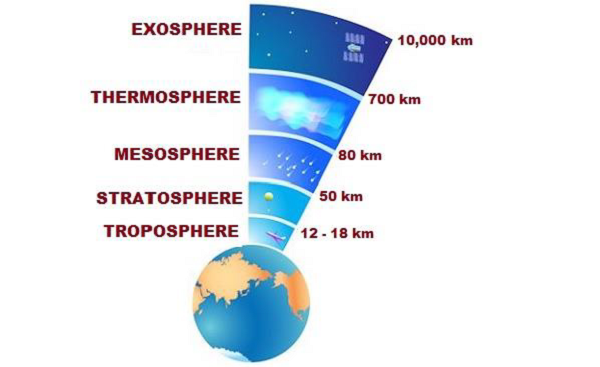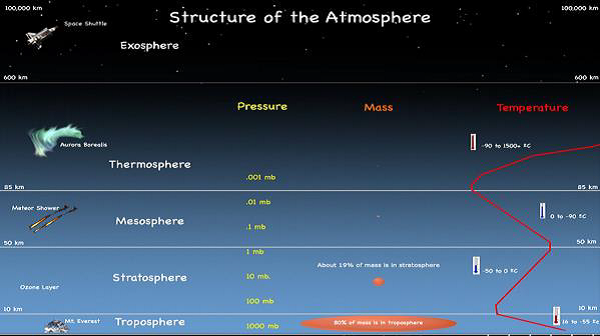The composition of the Earth’s atmosphere changes with the altitude.
The major constituents of the Earth’s atmosphere are −
Nitrogen – 78.09%
Oxygen – 20.95%
Argon – 0.93%
Carbon Dioxide – 0.039% (remaining other gasses)
The pressure exerted by the weight of air at a given point is known as “Atmospheric Pressure” or “Barometric Pressure.”
With increasing altitude, the atmospheric pressure decreases.
On an average, a column of air (which is normally one square centimeter in cross-section), measured at the sea level, has the weight of about 1.03 kg (about 10.1 N).
The Average Air Pressure is about 14.70 pounds per square inch, (equivalent to 1,013.25 × 103 dynes per square centimeter or 1,013.25 millibars) at the sea level.
A visible mass of condensed vapor floating above the general level of the ground is known as Cloud.
Based on the altitude, cloud is classified as −
High Altitude Cloud: For example, Cirrus, Cirrocumulus, & Cirrostratus.
Middle Altitude Cloud: For example, Altostratus and Altocumulus.
Low Altitude Cloud: Stratus, Stratocumulus, Cumulus, and Nimbostratus (it can be also seen in the middle altitude).
Vertical: Cumulonimbus

The structure of the atmosphere is classified into the following layers −
Troposphere: 0 to 12 km
Stratosphere: 12 to 50 km
Mesosphere: 50 to 80 km
Thermosphere: 80 to 700 km
Exosphere: 700 to 10,000 km
Troposphere
Troposphere is the closest to the Earth’s surface and contains water vapor (clouds), moisture, dust, etc.
Most of the weather phenomena take place in Troposphere.

Height of the Troposphere varies i.e. at the equator, it is measured about 18 km and at the poles, it is 12 km.
Tropopause is the transitional zone that separates Troposphere and Stratosphere.
Stratosphere
Stratosphere is the second-lowest layer of the Earth’s Atmosphere that goes up to 50 km.
Stratosphere contains Ozone (O3) Layer that absorbs the ultraviolet rays (coming through the Sun rays) and protects life on the Earth.
As the ultraviolet radiation absorbs in Stratosphere, therefore the temperature rises with increasing altitude.
The Stratopause is the transitional zone that separates Stratosphere and Mesosphere.
Mesosphere
Mesosphere, present above the Stratosphere, extends up to (from 50 km to) 80 km.
Temperature in the Mesosphere decreases with increasing altitude.
Mesopause is the transitional zone that separates Mesosphere and Thermosphere.
Thermosphere
Above the Mesosphere, Thermosphere is the second-highest layer that starts at the altitude of 80 km and extends up to (roughly) 700 km (however, it varies between 500 and 1000 km).
The lower part of the Thermosphere (roughly between 80 km and 550 km) contains ions and known as Ionosphere.
The temperature of the Thermosphere rises with increasing altitude.
Thermopause is the transitional zone that separates Thermosphere and Exosphere.
Exosphere
Exosphere is the highest or outermost layer of the Earth’s atmosphere that extends (starting from 700 km altitude) up to 10,000 km where it ultimately merges into the solar wind.
Major constituents of the Exosphere are helium, hydrogen, nitrogen, oxygen, and carbon dioxide.
The phenomena of Aurora Borealis and Aurora Australis can be seen in the lower part of the Exosphere (merged with upper part of the Thermosphere).

The Satellite (orbiting the Earth) is normally placed in the Exosphere (as shown in the image given above).

ಕಾಮೆಂಟ್ಗಳಿಲ್ಲ:
ಕಾಮೆಂಟ್ ಪೋಸ್ಟ್ ಮಾಡಿ